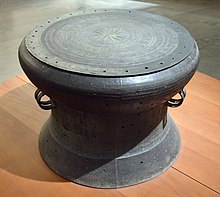Dong Son culture
| Part of a series on |
| Prehistoric and ancient cultures of Vietnam |
|---|
| Paleolithic |
| Sơn Vi culture (20,000–12,000 BC) |
| Mesolithic |
| Hoabinhian (12,000–10,000 BC) |
| Neolithic |
|
| Bronze Age |
|
| Iron Age |
|


The Dong Son culture or the Lạc Việt culture (named for modern village Đông Sơn, a village in Thanh Hóa, Vietnam) was a Bronze Age culture in ancient Vietnam centred at the Red River Valley of northern Vietnam from 1000 BC until the first century AD.[1]: 207 Vietnamese historians attribute the culture to the states of Văn Lang and Âu Lạc. Its influence spread to other parts of Southeast Asia, including Maritime Southeast Asia, from about 1000 BC to 1 BC.[2][3][4]
The Dong Son people were skilled at cultivating rice, keeping water buffalos and pigs, fishing and sailing in long dugout canoes. They also were skilled bronze casters, which is evidenced by the Dong Son drum found widely throughout northern Vietnam and South China.[citation needed]
To the south of the Dong Son culture was the Sa Huỳnh culture of the proto-Chams.
Identity[]
People of the Dong Son culture spoke either Austronesian[5][6][7][8] or Northern Tai languages;[9] or were Austroasiatic-speakers with significant contact and admixture with Tai-speakers.[10]
Ferlus (2009) showed that the inventions of pestle, oar, and a pan to cook sticky rice, which is the main characteristic of the Đông Sơn culture, correspond to the creation of new lexicons for these inventions in Northern Vietic (Việt–Mường) and Central Vietic (Cuoi-Toum).[11] The new vocabularies to denote these inventions were proven to be derivatives from original verbs rather than borrowed lexical items. The current distribution of Northern Vietic also correspond to the area of Dong Son culture. Thus, Ferlus conclude that the Dongsonian culture was of Vietic origin and they were the direct ancestors of modern Vietnamese people.[11]
Origins[]

The origins of Dong Son culture may be traced back to ancient bronze castings. However, according to archaeological discoveries in Isan, Thailand in the 1970s, the casting of bronze began in Southeast Asia first.[12] The Dong Son bronze industry has a local origin, equivalent in timing to the Gò Mun culture, 700-500 BC. This includes bronze axes, spearheads and knives.
The bronze drums were used for war, "the chief summons the warriors of the tribe by beating the drum", when mourning, and during feasts. "The scenes cast onto the drums would inform us that the Dong Son leaders had access to bronze founders of remarkable skill." Lost-wax casting was based on Chinese founders, but the scenes are local, including drummers and other musicians, warriors, rice processing, birds, deer, war vessels, and geometric designs.[1]: 200–202
The bronze drums were made in significant proportions in northern Vietnam and parts of Yunnan. The Dong Son bronze drums exhibit "remarkable skill". The Cổ Loa drum weighs 72 kilograms (159 lb) and would have required the smelting of between 1 and 7 tonnes (1.1 and 7.7 tons) of copper ore.[1]: 200
Displays of the Đông Sơn drum surface can be seen in some of Vietnam's cultural institutions. [13]
See also[]
- Lạc Việt
- Dong Son drum
- Austronesia
- Nanyue
- Âu Lạc
- Baiyue
References[]
- ^ a b c Higham, C., 2014, Early Mainland Southeast Asia, Bangkok: River Books Co., Ltd., ISBN 9786167339443
- ^ Vietnam Tours Archived 2013-04-26 at the Wayback Machine
- ^ Nola Cooke, Tana Li, James Anderson - The Tongking Gulf Through History - Page 46 2011 -"Nishimura actually suggested the Đông Sơn phase belonged in the late metal age, and some other Japanese scholars argued that, contrary to the conventional belief that the Han invasion ended Đông Sơn culture, Đông Sơn artifacts, ..."
- ^ Vietnam Fine Arts Museum 2000 "... the bronze cylindrical jars, drums, Weapons and tools which were sophistically carved and belonged to the World famous Đông Sơn culture dating from thousands of years; the Sculptures in the round, the ornamental architectural Sculptures...."
- ^ Paine, Lincoln (2013-10-29). The Sea and Civilization: A Maritime History of the World. Knopf Doubleday Publishing Group. p. 171. ISBN 978-0-307-96225-6.
- ^ Emigh, John (1996). Masked Performance: The Play of Self and Other in Ritual and Theatre. University of Pennsylvania Press. p. 95. ISBN 978-0-8122-1336-2.
- ^ Ooi, Keat Gin (2004). Southeast Asia: A Historical Encyclopedia, from Angkor Wat to East Timor. ABC-CLIO. p. 496. ISBN 978-1-57607-770-2.
- ^ Carpenter, Bruce W. (2012). Ethnic Jewellery from Indonesia: Continuity and Evolution : the Manfred Giehmann Collection. Editions Didier Millet. p. 16. ISBN 978-981-4260-68-8.
- ^ Schliesinger, Joachim (2018). Origin of the Tai People 6―Northern Tai-Speaking People of the Red River Delta and Their Habitat Today Volume 6 of Origin of the Tai People. Booksmango. pp. 3–4, 22. ISBN 978-1641531832.
- ^ Alves, Mark (2019-05-10). "Data from Multiple Disciplines Connecting Vietic with the Dong Son Culture". Cite journal requires
|journal=(help) - ^ a b Ferlus, Michael (2009). "A Layer of Dongsonian Vocabulary in Vietnamese" (PDF). Journal of the Southeast Asian Linguistics Society. 1: 95–108.
- ^ Taylor, Keith W. (1991). The Birth of Vietnam. University of California Press. p. 313. ISBN 0-520-07417-3.
- ^ VietnamPlus (2021-10-26). "38th and 39th ASEAN Summits open | World | Vietnam+ (VietnamPlus)". VietnamPlus. Retrieved 2021-10-27.
External links[]
| Wikimedia Commons has media related to Đông Sơn culture. |
- Đông Sơn culture
- Ancient Vietnam
- Prehistoric Thailand
- Archaeological cultures of Southeast Asia
- Archaeological cultures in Vietnam
- Bronze Age cultures of Asia
- 1st millennium BC in Vietnam